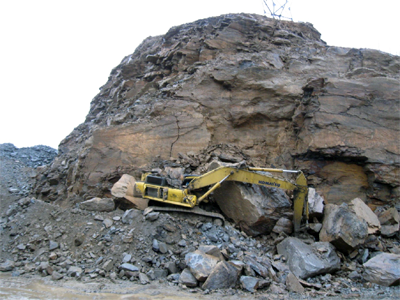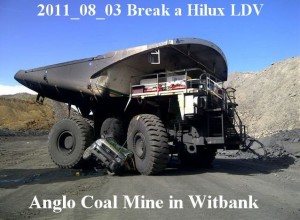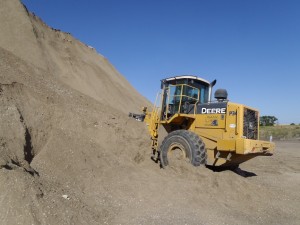Contents
Objectives
Upon completion of this lesson students will be able to:
- Analyze accidents and contributing factors.
- Identify causes of accidents.
- Explain Miner’s responsibility.
- Demonstrate proper handling of accidents.
Reading & Lecture
Analysis of Accidents and Contributing Factors
Definition of an Accident:
- Any unplanned and unanticipated event that results in personal injury and/or in property damage.
- An analysis of accidents must consider a number of contributing factors, which must at least include the accident type (falls, being struck by object), energy source (electricity, machinery), unsafe acts or conditions, nature of the injury, and the affected part or parts of the body.
Causes of Accidents
Basic causes of accidents may be one or more elements in the following lists.
- Management safety policy and decisions
- Production and safety goals
- Communications
- Inspection procedures
- Maintenance
- Housekeeping
- Environmental factors
- Weather
- Dusts, gases and vapors
- Noise
- Illumination
- Personal factors
- Safety motivation and awareness
- Knowledge and training
- Physical and mental state
- Reaction time
Indirect Causes
Review this video introduction to unsafe acts and preventative safety methods.
Unsafe acts
- Operating equipment at excessive speeds
- Operating equipment without authorization or training
- Using equipment or tools improperly
- Using defective equipment
- Removing or damaging safety devices on equipment
- Not using personal protective equipment when appropriate
- Not warning others of hazardous conditions
- Failure to secure equipment and block tires
- Improper lifting, loading, or placement of equipment, tools, or supplies
- Servicing equipment in motion
- Horseplay
- Use of alcohol or drugs
Unsafe Conditions
- Sliding or falling material at bins, hoppers, and dump points
- Pressure lines and vessels
- Inadequate supports or guards
- Poor housekeeping
- Poor illumination
- Hazardous highwalls, spoil banks, and water pools
- Fire and explosion hazards
- Defective tools, equipment, or supplies
- Congestion of work place
- Inadequate warning systems
- Excessive noise
- Slippery or rough haulage and walkways



Direct Causes
- Unplanned release of energy and/or hazardous material such as falls of rock or materials, failing brakes, or removal of air hose without bleeding the line
Distinction between health and safety concerns in the mine
- Health refers to proper functioning of the body
- Health is affected by substance which interfere with normal functioning.
- Health problems, while slow in occurring, may be permanently disabling
- Safety refers to avoiding accidents by following safe work procedures and recognizing and correcting unsafe conditions.
Miner’s responsibility
- Reporting hazards
- Tagging unsafe equipment
- Eliminating known hazards
- Warning others
- Avoiding areas of hazards
Common Types of Accidents
Most Common Types of Accidents in Metal/Nonmetal Underground Mines
Handling materials is a common activity related to accidents (lifting, puffing, pushing or shoveling packaged or loose material).
Frequency of Occurrence
Of all accidents reported in 1979 for underground mines, 31% occurred during handling of materials.
Accident Characteristics
Of all accidents in underground mines involving materials handling, 62% resulted in lost work days for non-fatally injured miners. The average severity of these accidents was lost time ranging from 12 to 164 days.
Most frequent parts of body injured in accidents
Most frequent nature of injury
These accidents may often be avoided by using correct procedures for handing materials.
- Use proper lifting, lifting with the legs rather than the back.
- Wear gloves.
- Do not allow your vision to be obscured by the load and be careful when passing through entrances.
- Do not attempt to carry a load which is too heavy, and coordinate your moves with those assisting you.
- Be careful of sharp edges or protruding sides of the materials you are carrying.
- When setting materials down, make sure you have sufficient clearance from your toes.
Accidents Caused By Powered Haulage Activities
Powered haulage activities are another source of accidents (conveyors, front-end loaders, haulage trucks, locomotives and railroad cars, and personnel conveyances).
Frequency of occurrence
Of all accidents reported in 1979 for underground mines, 8% occurred around powered haulage.
Accident characteristics
Of all accidents in underground mines involving powered haulage, 74% resulted in lost work days for non-fatally injured miners. The average severity of these accidents was lost time ranging from 30-210 days.
Most frequent parts of body injured in accidents
Most frequent nature of injury
Some of the sorts of haulage accidents which occur are as follows:
- Collisions with other vehicles or stationary objects
- Being struck, run over by or squeezed between vehicles
- Striking arms, legs, or other body parts against protruding objects while riding in mine transportation
- Slipping or falling while mounting vehicle
Haulage accidents may be reduced by using the rules as follows:
- Never exceed the vehicle’s capabilities for speed, stop-ping, and turning.
- When on foot watch out for all vehicles and let operators know you are near.
- Never get on or off of moving vehicles of any kind.
- Keep limbs and head within the riding area.
- Make frequent inspections of vehicle’s brakes, lights, steering, and other devices related to safety.
- Don’t work on moving conveyor belts or attempt to cross or mount them.
- Don’t wear loose clothing or long hair around moving conveyor belts or machinery which has exposed moving parts.
- When shoveling onto a moving belt, always shovel in the direct the belt is moving.
Accidents Caused By Use of Machinery
Another major source of accidents is the use of machinery (drills, slushers, power shovels, and compressors).
Frequency of occurrence
Of all accidents reported in 1979 for underground mines, 17% occurred around machinery.
Accident characteristics
Of all accidents in underground mines involving machinery, 64% resulted in lost work days for non-fatally injured miners. The average severity of these accidents was lost time ranging from 18 to 194 days.
Most frequent parts of body injured in accidents
Most frequent nature of injury
The sorts of accidents which occur are as follows:
- Being caught between a machine and the highwall during a slide.
- Being struck by a moving boom or bucket or blade
- Being struck or crushed by falling or overturning equipment.
- Being struck by flying objects.
Many accidents of this nature can be avoided by following safe work procedures.
- When working near equipment in operation, be sure the operator knows you are there.
- Avoid the area included in the circle of movement of booms and loaders. Never walk under raised equipment.
- Never leave equipment unattended in raised position.
- Be sure equipment is securely blocked before attempting any repair or maintenance with it in raised position.
- Never attempt to defeat or override the safety devices built into equipment.
Injuries form Slips and Falls
Another source of accidents is slips and falls (while getting on or off machinery and haulage equipment which is not moving, and while servicing or repairing equipment or machinery).
Frequency of occurrence
Of all accidents in 1979 for underground mines, 13% resulted from slips and falls.
Accident characteristics
Of all accidents in underground mines resulting from slips and falls, 73% resulted in lost work days for non-fatally injured miners. The average severity of these accidents was lost time ranging from 21 to 210 days.
Most frequent parts of body injured in accidents
Copy this chart
Most frequent nature of injury
Some rules which will prevent slips and falls are as follows:
- Wear proper footwear.
- Always watch where you are going. Don’t allow material being carried to block your visibility.
- Use both hands when climbing up or down a ladder. Never jump from rung to rung or try to slide down the ladder.
- Clean up any spills that might cause someone to slip.
- Never lean over equipment without stable footing.
- Use a safety belt to catch any fall from a high place, or when working in a hole or trench.
Injuries From Use of Hand Tools
An additional major source of accidents is the use of hand tools (non-power assisted tools)
Frequency of occurrence
Of all accidents in 1979 for underground mines, 11% resulted from use of hand tools.
Accident characteristics
Of all accidents in underground mines resulting from use of hand tools, 45% resulted in lost work days for non-fatally injured miners. The average severity of these accidents was lost time ranging from 11 to 125 days.
Most frequent parts of body injured in accidents
Most frequent nature of injury
The following are procedures which will help in avoiding these accidents.
- Use the right tool for the job.
- Keep tools in their place when they are not being used. Don’t leave them around as hazards to safety.
- Be sure you have clearance from other workers and machinery when using hammers and sledges.
- Always wear safety glasses to protect your eyes from flying material.
- Follow recommended safety procedures in the use of special tools and equipment.
Injuries From Falls to Back or Sides
The final major source of accidents is falls of the back or sides. This includes falls while barring down or placing props, as well as pressure bumps and bursts. This does not include accidents due to equipment gouging the rock.
Frequency of occurrence
Of all accidents in 1979 for underground mines, 10% resulted from falls of the back or sides.
Accident characteristics
Of all accidents in underground mines resulting from falls of the back or sides, 65% resulted in lost work days for non-fatally injured miners. The average severity of these accidents was lost time ranging from 12 to 600 days.
Most frequent parts of body injured in accidents
Most frequent nature of injury
These accidents may often be avoided by observing some of the following safety rules.
- While barring down always follow safe procedures and keep a path for escape open. When scaling, always wear safety glasses and work under supported roof.
- If you suspect weak rock, report it to supervision.
- Test the rock periodically with a hammer to assess its soundness.
- Never violate the mine’s roof control plan.
- Look for stress cracks or rocks protruding from the back or sides.
- Look for formerly dry areas that suddenly become wet.
- Look for the falling of small chips that might signal larger falls.
- Look for rock bolts showing signs of stress.
- Never assume someone else has made tests in the area.